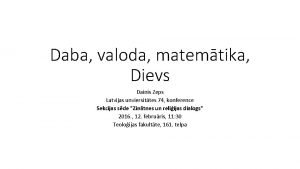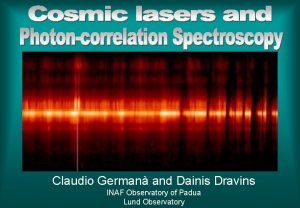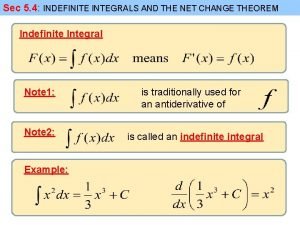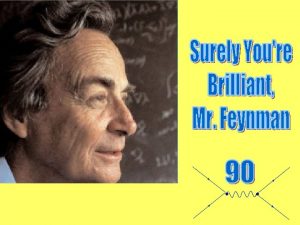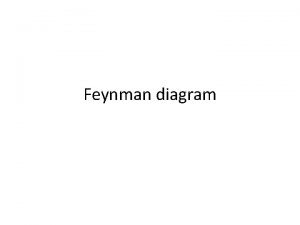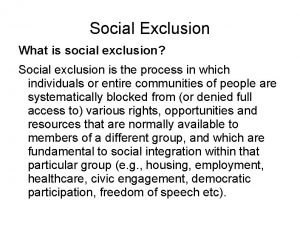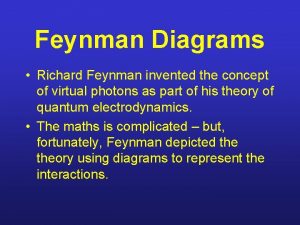Selfreference exclusion and Feynman path integral Dainis Zeps








- Slides: 8

Selfreference exclusion and Feynman path integral Dainis Zeps Institution of Mathematics and Computer Science http: //lingua. id. lv http: //www. ltn. lv/~dainize/idems. html

Self-reference systems http: //www. ltn. lv/~dainize/Math. Pages/self. systems. pdf • Let us differentiate in a system’s behviour the part of its elements being with themselves and the part where they interact between themselves. • The same system we may now consider as consisting from self-reference elements which are with themselves unless they are in interaction. • May we consider all our system now as some sort of self-reference system itself, consisting from self-refernce elements, or systems on their own rights? • Definition: self-reference system, or idem [pronounced ‘aidəm] is a pair: <state: s 1|state: s 2>, where system in state s 1 is with itself and in state s 2 it interacts with anything without itself. Simplest example: colliding balls: Ball’s state s 2: Ball’s life between collisions: its state s 1 or its selfreference In its life act of experience or interaction Ball’s life consists from selfreferences and experieces or interactions

Lifetime story • Let us consider system’s behaviour, excluding its selfreference part from consideration, considering only its experience part, and call it lifetime story. • In one element’s life its lifetime story would be sequence of experiences or interactions forming its lifetime experience. • What structure should possess lifetime story of all system and how to compute it? • Structure is multigraph. • Computation technique is Feynman path integral.

LTS structure - multigraph • All lifetime stories of individual elements of the system comprise on lifetime story that is multi-graph in very natural way, and mathematically too, • Multigraph reveals additional properties of the system that could usually remain unnoticed: how links are synchronized between similar experiences. Solving the problem usually, we consider it in temporal outline, i. e. , guided by the very basical low in nature, i. e. , causal relations’ low. But chosing some other rather noncausal shema we could find more general outline for our theory. One more unnoticed property of every mathematical problem: It may be made cyclical in very natural way, i. e. , in the way we depict multigraph on orientable surface. See left and imagine surfice which could saddle on it this multigraph.

Feynman path integral • • • What to do in a general case, when multigraph technique is not appropriate, e. g. , if we have smooth functions, and selfreference elements actually are taken from infinitisimal picture in order to result in continued macropicture? Then general technique is that taken from quantum electrodinamics – Feynman path integral technique, that has many applications in other scientific disciplines. First we take integral path from point a to point b of ‘system life’s’ manifold and thenafter vary points a and b over all points of the manifold. We receive the same cyclicity. What to do with noncausalities it is problem of its own, e. g. , we may chose patterns, if any, from QED or build ourselves appropriate for our problems. In QED Feynman path integral is applied in some ultimate way without excluding anything, unless inifinizimal picture - using some philosophical mood. We are going to use Feynman path integral appoach in sense of some general pattern, considering multigraph case as its simpler subcase, to exclude selfreferences actually and to try to find some general patterns of such exclusion.

Manifold of partial reality with exclusion • • • Let for example system consists of n independent blocks uless time to time communicating between themselves. We may describe each such block as idem and find system’s lifetime story with respect to these idems. We get multigraph which made into some smooth function called manifold of reality represents now systems action what concerns interconnection of their blocks where the actual actions of their blocks are excluded. Manifold of reality, or partial reality with some excluded part of reality, defined in this way always represents only some aspect of the imaginable common reality wheresoever. However, this partial reality is something quite precisely conceivable and, according quantum mechanical conceptuality, it is in superposition with that common imaginable reality even if we in no way could define it precisely, what should under it be understandable. If a system is sufficiently complicated it would have several levels of its partial realities, each representing its own complexity and competence. Each level characterizes specified selfreference which excludes references that are included in it as its substructure. Hierarchical system organized in this way could be representable as references, where higher reference excluding all lower defines itself, but, on the other hand, excluded itself, shows higher organization of the system.

Abstractions from simpler facts • Previously we considered system consisting from elements that were conceivable as idems and came to idem of all system. Using this approach, we follow the general pattern in mathematics, where, similarly as function is defined in its domain, our elementary idem is defined on all system. • However, we have another choice too. I. e. We find some idem and, without defining directly its domain, get it to know through lifetime story where, calculated using Feynman path integral, it gives us, among other things, domain where our idem works. Even more, we may not even know directly what it is, the domain where our idem works. Lifetime story computation always can do the job. Until, of course, very curious cases, when this domain is empty and all as if works and it doesn’t work together, because lifetime story comprise some empty structure.

Selfreference - Inclusion via excluding oneself • All that happen with vector bundles, gauging and whatsoever pilings of mathematical nature via connections, where heaps on heaps mathematical constructs are heaped one to another, all this works by a simple principle where every stratum is selfreferent where by itself’s exclusion joines into another picture.
